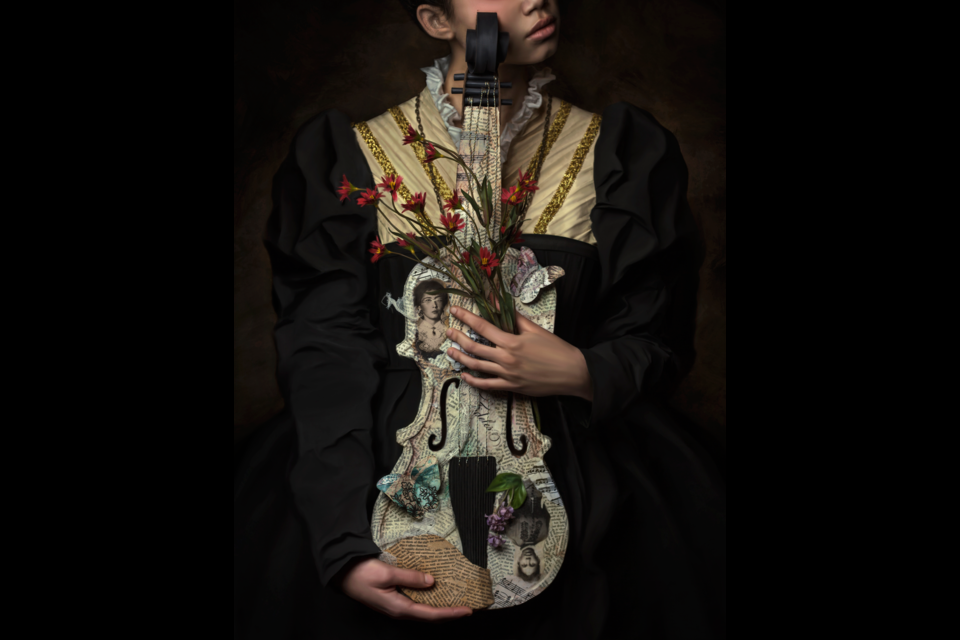From her cozy, pre-war apartment in Flatbush, Brooklyn, Fabiola Jean-Louis is making history and rewriting it all at once.
Over the past two and half years, this 37-year-old mother of three has gone from being an aspiring medical student, months away from a degree in biology, to become one of the most fast-emerging visionaries on New York City's creative art scene.
Today, Jean-Louis serves as a teaching artist at the Harlem School of Arts in its Visual Arts Department, where her project Rewriting History: Paper Gowns & Photographs was the featured solo exhibit in the school's gallery—an exhibit so awe-inspiring, it was extended another month before closing on April 1, 2016.
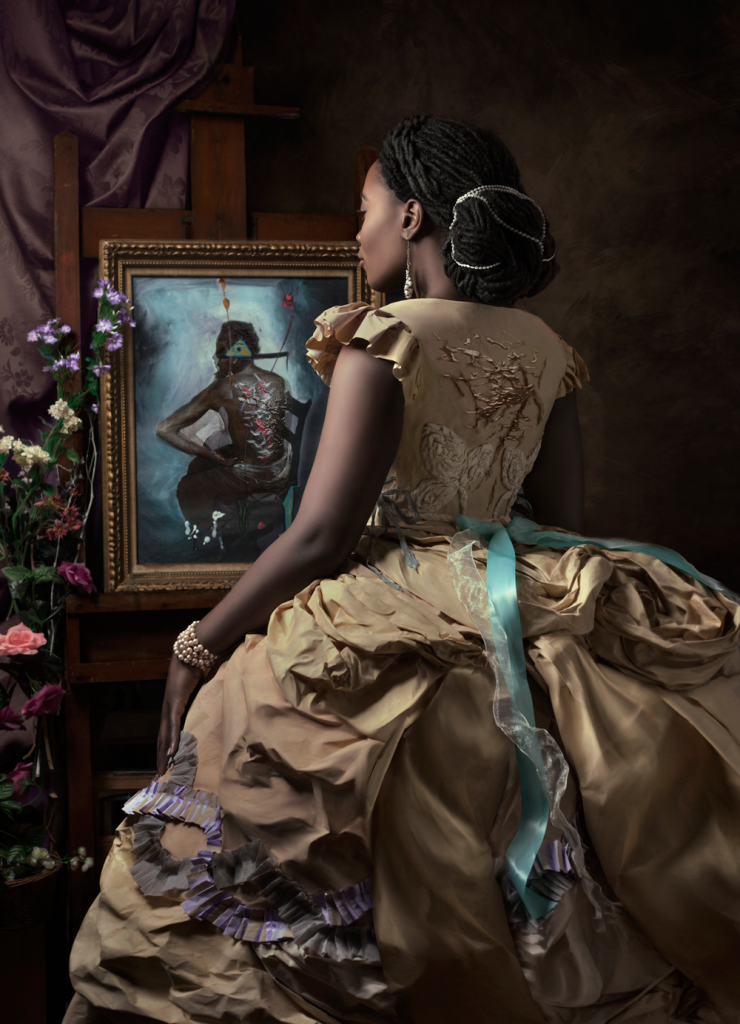
So what caused her sudden pivot from student to teacher and from biology to art? And what is it about her work that is setting the art industry abuzz?
Jean-Louis had her "Aha!" moment when she learned she could time travel. Yes, time travel: "Because if you think about it, we're always time traveling," she said. "While we're in the present, we're always thinking about our past and our future. So in essence, we're constantly moving through time."
And so by letting go of the idea her story is forever gilded in the past, she began to change the possibilities of her future. The result today is Jean-Louis is living out her highest creative potential and raising eyebrows with her latest alchemy— an artful serving of history, with a touch of time travel and a dash of magic.
Rewriting History is an assemblage of Victorian-style, Afro-futuristic photographs she manipulates meticulously to appear as paintings. But that's not all: The subjects of her paintings are fitted in gowns she designs and then constructs without sketches. And that's still not all: Every single last one of her gowns including the props are constructed out of paper!
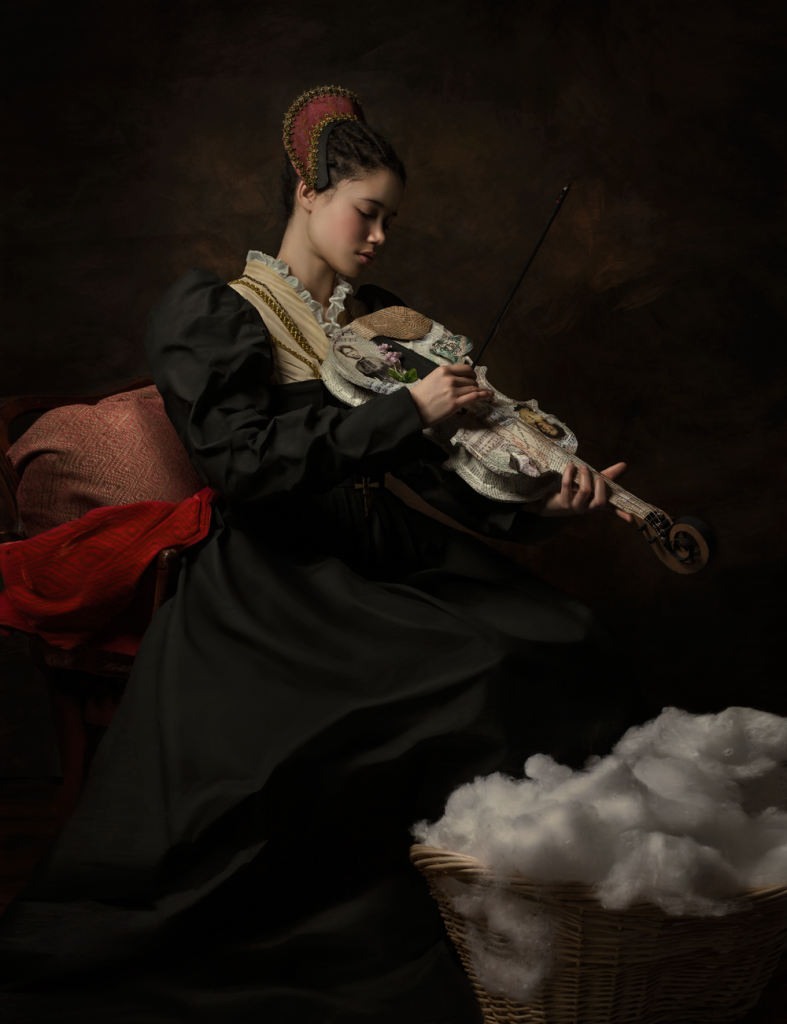
In "Passing," the young girl's dress is made of news print and drafting paper. The corset is made of paper mache to anchor the bottom of the dress. She used toilet paper for the ruffled collar and party streamers for the trimming. Where there is lacing, there is some fabric trimming and piping, which Jean-Louis says gives the dress structure and helps hold it onto the shoulders. But the rest of the dress is paper-- painted, folded, crumpled, treated and made to conform over the model's body. Even the head piece the subject is wearing and the violin she is holding is made out of cardboard and paper.
It's a lot to fully digest, I know. So let's back up to understand how it all started.
Born in Haiti, Fabiola Jean-Louis and her family moved to Harlem when she was one years old. She discovered around age 9 that she was an artist. It showed up as a child in almost everything— her constant drawing and painting, her fashion choices, not to mention all the murals and poetry scribbles strewn across her bedroom walls. But Jean-Louis's strict, hard-working Haitian parents had other ideas for their three children (Consequently, Jean-Louis's younger brother and older sister also showed creative ability), and art most certainly was not one of them. Jean-Louis's father who, ironically, was an artist, carpenter and tailor himself, chose a career in engineering.
"I think my father is a genius. He can build anything. But he used to tell me all the time that being an artist wasn't going to feed me or support my family," said Jean-Louis. "For Haitians, art is something that is very separate from anything. They just didn't see its part in life, and how it could be applied."
Nevertheless, during her "rebellious years," while attending Fashion Industries High School in the 90s, Jean-Louis immersed herself in the art world, as a way to push back against her parents' strict hand. This included often running away from home and hanging out as a club kid in Washington Square Park with other "creatives" who were also avoiding their home lives. Immediately after high school, at age 18, she left home, got married and eventually enrolled at the the Art Institute of Pittsburg. But the pressures of domestic life, marriage and money eventually took its toll, and she ended up shelving the idea of school.
Now a wife and a young mother of two girls, an art career seemed an unrealistic and unsustainable pipe dream. After divorcing from her husband, Jean-Louis had her third child, a son, found love again, got in engaged, and in 2011, enrolled in Nova Southeastern University in Miami as a biology major. Her new plan was to become a physician specializing in cancer research.
"Science fit me like a glove; I was surprised, because I had spent years studying art. I had not done science in school at all," said Jean-Louis. "Suddenly I was getting A's in classes that people who knew they were going to be scientists early had a hard time passing. And I was like, 'this is amazing!'"
And then two semesters before graduating with her BA in biology, and three months before her wedding, she and her fiancé broke off the engagement, and everything fell apart.
"I was heartbroken. That time was one of the biggest turning points in my adult life, as far as determining who I am," said Jean-Louis. "Everything suddenly became silent. I was forced to look at my life and decided I had to determine who I was. I realized, this is not what my ancestors wanted for me. I began to really look at how I see myself as a black woman in this world."
Around that same time, she came across an article on conceptual photography, and thought to herself, I can do this: "I had no camera, so I used my blackberry cell phone and started teaching myself. After a month, I realized that I actually had been doing more photography with my little cell phone, than my own science work," said Jean-Louis. "What really appealed to me was I wanted to create something I didn't need words for . I didn't want to talk; I just wanted to show."
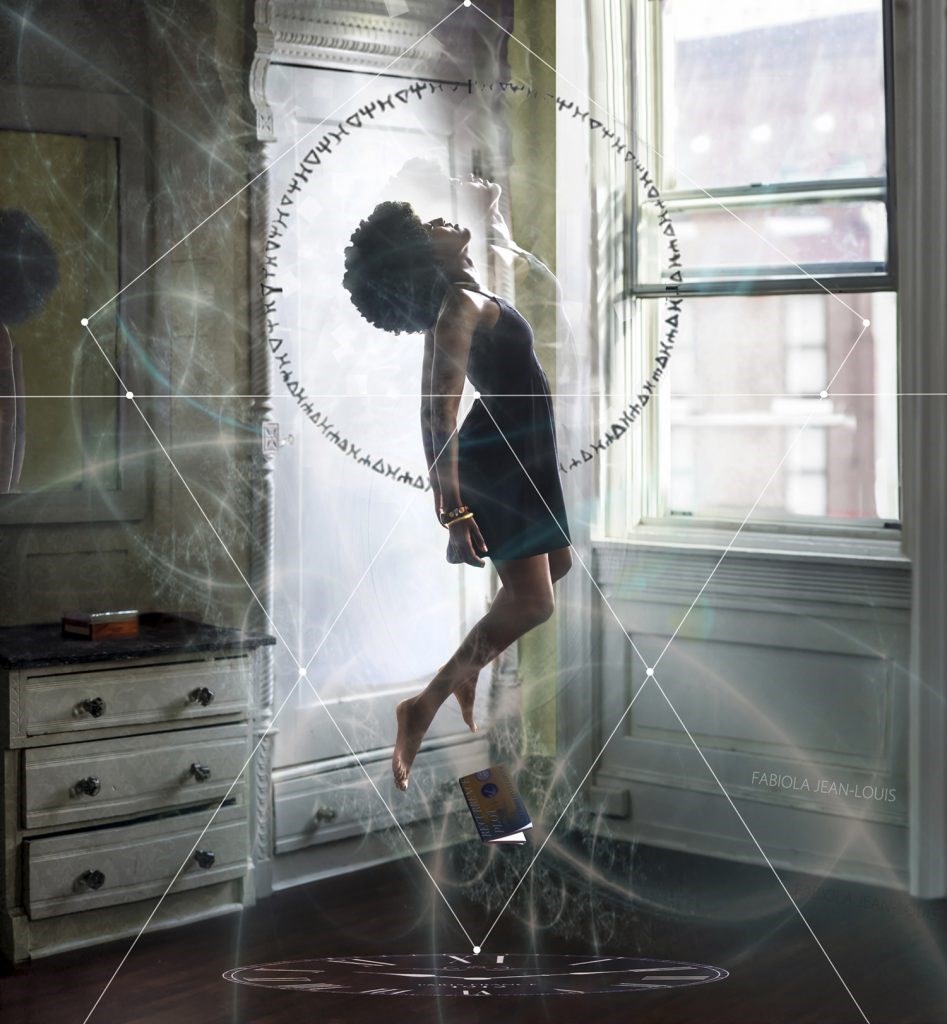
After a near-decade absence, Jean-Louis's artistic side was again speaking up, reemerging. Soon, the pain and disappointment became something else, Jean-Louis said. She began to feel happy and rejuvenated; photography became something that was healing her.
She said for the first time in her life, she let go of everything ever told to her about who she was, or who she should or should not be She let go and gave in to the possibility of becoming all the things she was, yet no particular thing, at once:
"Conceptual photography gave me a chance to blend science, technology, art and design-- everything I loved-- into one space," said Jean-Louis.
In no time, she mastered Photoshop. She also started collecting cameras, both vintage and new. Entirely self-taught and little by little, she began showing some of her conceptual photography work to friends and other trusted sources and was surprised at the overwhelming response.
Her photos were indeed special: Each held a vivid, soul-stirring, almost dream-like story where time was suspended at the intersection of the conscious and subconscious mind.
"There's always a story behind every image, and I always think of the lucid dream when I'm creating, because it seems to tap into a dream [the viewer] might have had." said Jean-Louis. "Also, when I'm creating, I am purposefully choosing colors and light effects I know on a general level are beautiful, because beauty is a wonderful vehicle to carry all the other truths when sometimes truths are not very pretty."
In 2014, she moved back to Brooklyn, and Rewriting History, her paper sculpture series, was born. Rewriting History is a haunting photographic essay that remixes garments worn by female European nobility between the 15th—19th centuries with the bodies, histories and stories of black women. The exhibit asks such questions as, How much has society really changed since the beginning of slavery? And do Black lives matter in the 21st century?
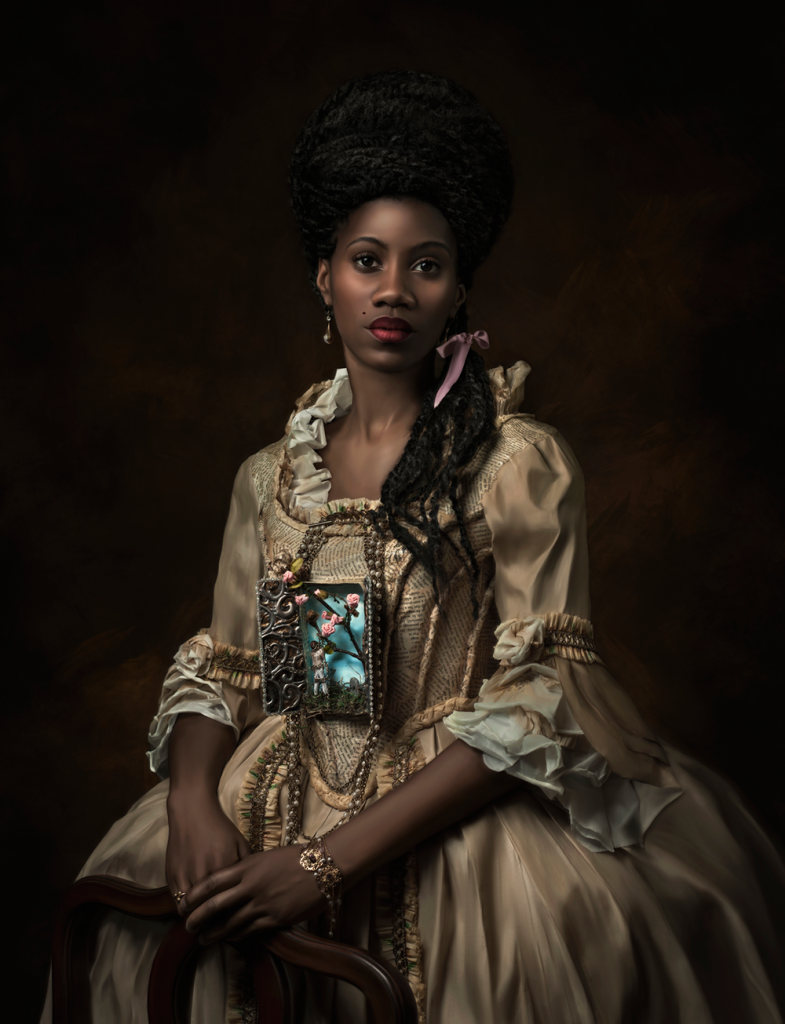
"I've always thought the paintings from that era were so beautiful. I thought, 'Wow, these women actually had the time and leisure to sit for these paintings,'" said Jean-Louis. "That says a lot, and I wanted that same thing for us, as black women. Yes, we too should have time to sit for a portrait to have our beauty captured. Except now, with science and technology, I am able to update the photos to represent a contemporary view on society today."
Beyond the stunning precision of the photos-come-paintings, there's another layer of astounding ingenuity, and that is all of the women subjects' ornate gowns were designed and constructed by Jean-Louis entirely with paper.
"When I decided I wanted to do something called 'rewriting history,' I thought, I can't afford to make these gowns out of fabric. But I don't have to follow the rules, so it should be something else. And I thought, rewriting history? It should be paper!
"Paper just was perfect to me, because I can ball it up, iron it, spray it with water. I can do things to it to make it work for me. It is delicate, but it trains me to have a more delicate hand in the craft—not only in making the paper, but everything else I do.
"The paper was never planned. It was never a medium I used before. But with paper, whatever I do, I can undo; I can cut it, I can glue it; I can tape it. I don't have to go by these set rules in drafting. I can literally put a paper on my subject and construct it right there on her body," she said.
"And there's something about paper that reminded me of the black experience, in the sense that it can take so much, so much but it's still delicate. It's all over the streets of New York City. It's this material that a lot of us forget after we've used it. I felt like, that's how black people have been treated throughout history-- something you use, and then forget.
"But yet, paper holds so many stories; so much power. It conveys language, communication it holds the spells and the prayers that my grandmother wrote down. If you think about the Constitution being written down on paper, that power that cemented so much for us, moving forward, even to today ."
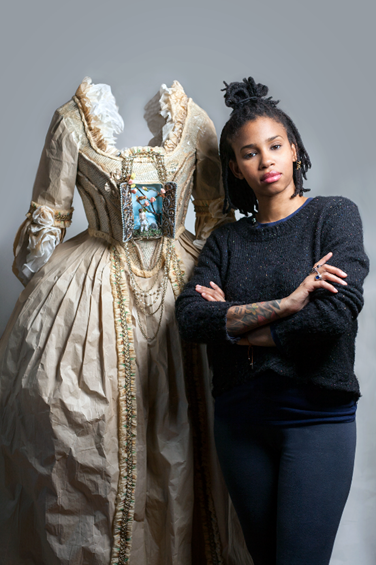
Through the use of paper, Jean-Louise suggests that although we cannot change the past, we can act to change the present, as we activate the memories, visions and legacies of our ancestors.
The public response to Jean-Louis and her paper gowns has been overwhelming. The Madam Leroy photo already was used as a cover image for a leading Norwegian theater magazine. Jean-Louis and her paper sculpture series currently are represented by Alan Avery Art Company in Atlanta, where she will hold her next solo show next fall.
With three dresses and one half garment completed, Jean-Louis is working on the next full gown now. The goal is 10-12 dresses total and 30 images when completed, and then a book to close out the series. She said she hopes one day soon the entire body of work will be accepted at the Studio Museum in Harlem and/or the Schomburg Center for Research in Black Culture.
Who would have guessed 30 months ago that a broken heart and a camera phone would end up leading Fabiola Jean-Louis down a paper trail back to her true self? Jean-Louis says it's possible for anyone if you simply give yourself permission to just be.
Whether you view Jean-Louis's journey as one that has been long-traveled or whether you view it as a meteoric rise is unimportant, particularly when you're a time traveler. This Afro-futuristic artist just wants to be a vehicle to create something beautiful-- something that inspires others to push past superficial boundaries and false narratives of what's possible for themselves.
"Which is what Rewriting History is about; it's about finding and exposing truths," said Jean-Louis. "And it's not always a pretty truth. At all. But I am using the vehicle of beauty to carry that."

